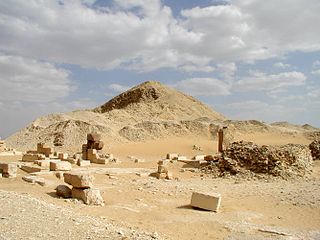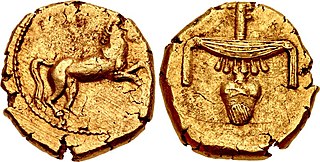The 22nd century BC are the years between 2200 and 2101 years before the birth of Jesus Christ.

Pepi II Neferkare was a pharaoh of the Sixth Dynasty in Egypt's Old Kingdom who reigned from c. 2278 BC. His second name, Neferkare (Nefer-ka-Re), means "Beautiful is the Ka of Re". He succeeded to the throne at age six, after the death of Merenre I.

Pepi I Meryre was an ancient Egyptian pharaoh, third king of the Sixth Dynasty of Egypt, who ruled for over 40 years at the turn of the 24th and 23rd centuries BC, toward the end of the Old Kingdom period. He was the son of Teti, the founder of the dynasty, and ascended the throne only after the brief intervening reign of the shadowy Userkare. His mother was Iput, who may have been a daughter of Unas, the final ruler of the preceding Fifth Dynasty. Pepi I, who had at least six consorts, was succeeded by his son Merenre Nemtyemsaf I, with whom he may have shared power in a coregency at the very end of his reign. Pepi II Neferkare, who might also have been Pepi I's son, succeeded Merenre.
The Eighth Dynasty of ancient Egypt is a poorly known and short-lived line of pharaohs reigning in rapid succession in the early 22nd century BC, likely with their seat of power in Memphis. The Eighth Dynasty held sway at a time referred to as the very end of the Old Kingdom or the beginning of the First Intermediate Period. The power of the pharaohs was waning while that of the provincial governors, known as nomarchs, was increasingly important, the Egyptian state having by then effectively turned into a feudal system. In spite of close relations between the Memphite kings and powerful nomarchs, notably in Coptos, the Eighth Dynasty was eventually overthrown by the nomarchs of Heracleopolis Magna, who founded the Ninth Dynasty. The Eighth Dynasty is sometimes combined with the preceding Seventh Dynasty, owing to the lack of archeological evidence for the latter which may be fictitious.

Merenre Nemtyemsaf II was an ancient Egyptian pharaoh, the sixth and penultimate ruler of the 6th Dynasty. He reigned for 1 year and 1 month in the first half of the 22nd century BC, at the very end of the Old Kingdom period. Nemtyemsaf II likely ascended the throne as an old man, succeeding his long-lived father Pepi II Neferkare at a time when the power of the pharaoh was crumbling.

Neferkare Neby was an ancient Egyptian pharaoh of the Seventh or Eighth Dynasty during the early First Intermediate Period. According to Egyptologists Jürgen von Beckerath and Darrell Baker, he was the fourth king of the Seventh dynasty, as he appears as the fourth king in the Abydos King List within the list of kings assigned to this dynasty.

Neferkare VI Pepiseneb was an ancient Egyptian pharaoh of the Eighth Dynasty during the early First Intermediate Period. According to the Egyptologists Kim Ryholt, Jürgen von Beckerath and Darrell Baker he was the twelfth king of the Eighth Dynasty.

Neferkamin Anu was a pharaoh of ancient Egypt during the First Intermediate Period, c2181 - 2055 BC. According to the Abydos King List and the latest reconstruction of the Turin canon by Kim Ryholt, he was the 13th king of the Eighth Dynasty. This opinion is shared by the Egyptologists Jürgen von Beckerath, Thomas Schneider and Darrell Baker. As a pharaoh of the Eighth Dynasty, Neferkamin Anu would have reigned over the Memphite region.

Neferirkare was an ancient Egyptian pharaoh of the Eighth Dynasty during the early First Intermediate Period. According to the egyptologists Kim Ryholt, Jürgen von Beckerath and Darrell Baker he was the 17th and final king of the Eighth Dynasty. Many scholars consider Neferirkare to have been the last pharaoh of the Old Kingdom, which came to an end with the 8th Dynasty.

Ankhesenpepi II or Ankhesenmeryre II was a queen consort during the Sixth Dynasty of Egypt. She was the wife of Kings Pepi I and Merenre Nemtyemsaf I, and the mother of Pepi II. She likely served as regent during the minority of her son. She was buried in a pyramid in Saqqara.
Neith was an ancient Egyptian queen consort, one of the principal queens of the Old Kingdom pharaoh Pepi II Neferkare, who ruled. Queen Neith was named after goddess Neith.
Neferkare VII was the third pharaoh of the Ninth Dynasty of Egypt of ancient Egypt, ca. 2140 BCE, according to the Turin King List where his name, Neferkare, is inscribed in the register 4.20.
Neferka was an ancient Egyptian pharaoh of the Sixth Dynasty, who briefly reigned around 2200 BC.
Iput was an ancient Egyptian queen consort of the Sixth Dynasty, a sister and wife of Pepi II.

Ankhesenpepi IV was an ancient Egyptian queen, a wife of Pharaoh Pepi II of the Sixth Dynasty. She was the mother of a crown prince Neferkare. Pepi II also had several other wives.
Udjebten or Wedjebten was an ancient Egyptian queen consort, a wife of Pharaoh Pepi II of the Sixth Dynasty.
Meritites IV was a queen from the Sixth Dynasty. She was believed to be a wife of Pepi I Meryre, but her title of King’s Daughter of his body of Pepy-Mennefer (s3t-niswt-nt-kht.f-ppy-mn-nfr) is now understood to indicate that she was a daughter of Pepi I Meryre and wife of a king Neferkare, presumably Pepi II. One more evidence for that theory is that her name means "Beloved of her father".
This page list topics related to ancient Egypt.
Neferkare VIII was the second pharaoh of the 10th Dynasty of ancient Egypt.

The gold stater was the first coin ever minted in ancient Egypt, around 360 BC during the reign of pharaoh Teos of the 30th Dynasty.









